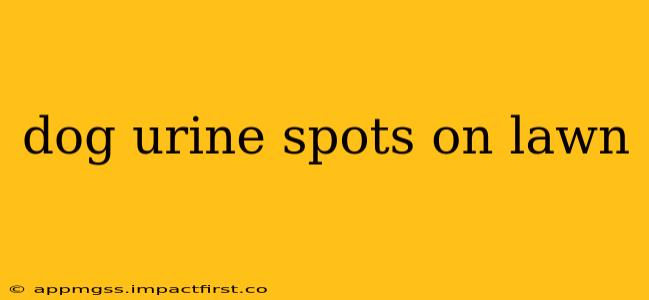Dog urine, while a natural byproduct, can unfortunately cause unsightly brown patches on your otherwise lush lawn. These spots are a common frustration for dog owners, but understanding the cause and employing effective solutions can help restore your yard's beauty. This comprehensive guide will address the issue of dog urine spots on your lawn, providing practical solutions and preventative measures.
Why Does Dog Urine Burn My Lawn?
Dog urine contains nitrogen, a vital nutrient for plant growth. However, the concentrated amount of nitrogen in canine urine, particularly from male dogs, can "burn" the grass, leading to those noticeable brown patches. The high nitrogen level essentially over-fertilizes the area, causing the grass blades to die back. The higher the concentration of nitrogen, the more severe the damage will be. Factors like diet, hydration level of the dog, and the type of grass all play a role in the severity of the damage.
How to Identify Dog Urine Spots
Identifying dog urine spots is usually straightforward. They typically appear as:
- Circular brown patches: These are the most common sign, often appearing directly where your dog urinates.
- Yellowing or browning grass: The color change can be quite noticeable, especially compared to the surrounding healthy grass.
- Wilting or dead grass: In severe cases, the grass in the affected area might completely die.
- Location: Spots tend to appear in areas where your dog frequently urinates, often near trees, fences, or other landmarks.
How to Treat Dog Urine Spots on Your Lawn
Treating existing dog urine spots involves several steps, depending on the severity of the damage:
- Watering the affected area: Diluting the concentrated urine is crucial. Thoroughly water the affected area immediately after your dog urinates. This helps to disperse the nitrogen and reduce its impact on the grass.
- Applying a diluted urine neutralizer: Many commercial products are designed to neutralize the nitrogen in dog urine. Always follow the product instructions carefully.
- Aerating the soil: Aerating improves drainage and allows the soil to better absorb water and nutrients, reducing the risk of future burns.
- Topdressing with compost or topsoil: This helps to improve the soil's composition, adding nutrients without over-fertilizing.
- Reseeding or overseeding: In severe cases, you may need to reseed or overseed the damaged areas to replace the dead grass with new growth.
What can I put on my lawn to neutralize dog urine?
Several commercial products are designed to neutralize the nitrogen in dog urine and can be found at most garden centers or online. These often contain enzymes that break down the urea in urine, reducing its impact. Always carefully follow the product instructions for best results. It's also important to note that some home remedies, while suggested online, are not always effective or may even harm your lawn.
Can dog urine damage kill my grass?
Yes, if left untreated, high concentrations of nitrogen in dog urine can indeed kill your grass. This is especially true if your dog frequently urinates in the same spot. The high nitrogen level burns the grass blades, causing them to die back and resulting in noticeable brown patches.
How do I prevent dog urine damage to my lawn?
Prevention is always better than cure. The following strategies can significantly reduce the risk of dog urine damage:
- Encourage your dog to urinate in different areas: Train your dog to urinate in various locations across your lawn. This disperses the concentrated nitrogen more evenly, reducing the impact on any one area.
- Provide plenty of water for your dog: Diluted urine is less damaging. Ensuring your dog drinks plenty of water will dilute their urine, minimizing the negative effect on your lawn.
- Feed your dog a high-quality diet: Some dog foods can contribute to more concentrated urine. A balanced diet may help to reduce the nitrogen content.
- Water your lawn regularly: Regular watering helps to dilute urine and keep the soil moist, making it less susceptible to damage.
By understanding the causes of dog urine spots, implementing effective treatment strategies, and employing preventative measures, you can maintain a healthy and beautiful lawn despite canine companionship. Remember, patience and consistent effort are key to success.
